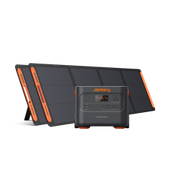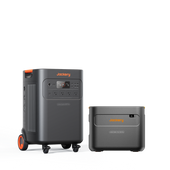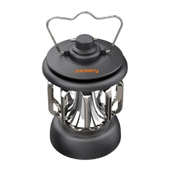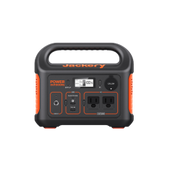The White River in Arkansas has gained a reputation for being one of the most prolific habitats for various trout species. The trout fishing industry plays a major role in the state’s recreational landscape, and visitors flock here for White River trout fishing for anything from brown to rainbow trout.
Some fishing trips might last a day, while others could be several days long. Being outdoors for such long durations requires keeping your devices charged and running certain appliances to make your trip comfortable. With Jackery Portable Power Stations, you can easily run most of your outdoor appliances and ensure you’re always connected to your loved ones. These compact portable power stations are easy to carry, so you’ll always have some power backup.
Key Takeaways
This section summarizes the key points discussed in this blog. They’re mentioned below:
- The trout fisheries in the White River in Arkansas are a popular destination for visitors nationwide.
- Trout succeed best in cooler temperatures, but you can fish for them all year round.
- Fishing trout requires certain gear, such as fishing rods, lines, reels, and the right bait.
- Trout are a very fragile species. While you can catch them recreationally, you must handle them carefully and release them back into the water.
- Jackery Portable Power Stations are a compact and versatile power backup option to accompany you on your fishing trips.
Latest News About White River Trout Fishing in the US
People living on the Little Red River in Arkansas noted a decline in the brown trout population, stating that destroying the species can lead to a significant loss in potential tourist revenue. Melinda Smith, the President of the local chapter of Trout Unlimited, stated that the trout population is almost spiritual to many people.
The Arkansas Game and Fish Commission (AGFC) has also studied brown trout movements in the Little Red River to analyze how flow rates and water temperatures affect their routines. With radio transmitters implanted in about 150 trout, they found some fascinating results, including that the fish traveled 806 miles up and down the river within just the first six weeks of being tagged.
Their studies aim to study this species in greater detail to understand how to design preservation efforts and ensure the consistent flow of revenue stemming from the popularity of the trout fisheries.
White River Trout Fishing Basics
The trout fisheries in the White River or Arkansas make this destination a hotspot for anglers looking to make their catch and fishing trip successful. The White River originates in the Boston mountains of northwest Arkansas, curves north towards Missouri, and then makes its way back to Arkansas.

One of the key attractions of the White River is that it remains open 365 days of the year with no closed seasons. As a result, anglers benefit from catching four different species of trout all through the year. However, the trout are not native to Arkansas, and their presence in the White River results from cold water discharged downstream by several U.S. Army Corps of Engineers dams.
One key reason the White River has become a hub for trout fishing is that the species is found in abundance. While the trout reaching downstream wiped out the native smallmouth bass and warm-water fish, this damage was mitigated by stocking the river with trout that can handle the colder temperatures well.
While brown trout can reproduce in these waters, rainbow trout need to be annually stocked in the river, a process that the AGFC takes care of. This is why the White River has a year-round supply of trout, making it the ideal destination for anglers.
Where Are the Trout in the White River?
To understand where you can go for White River trout fishing, you’ll have to adjust to the changing water levels and how these affect the movement of the fish underwater.

Two major environmental factors cause these changes in water levels and affect trout’s behavior. The first is that the water level constantly varies depending on how much water is released from the Bull Shoals Dam upstream. The second factor is that the temperature here is a constant 50°F (10°C) throughout the year. These cold temperatures and oxygen-rich waters make for the ideal habitat for trout.
However, there are instances when seasonal changes result in temperature changes, which also affect the trout’s behavior.
Developing a “stream sense” can help you understand where the fish are during different weather conditions. You’ll often find the trout in certain parts of the river. These parts offer the fish food, oxygen, and shelter. During stronger currents, the trout will find themselves on the outer banks of the river or in places close to submerged objects like rocks until the flood passes.
Another place you can find a greater concentration of trout is the Eddies, where the water flow is slower. This is where they feed on insects trapped in these small pools without worrying about strong currents.
Additionally, runs that occur after a rippling section or a shoal also offer trout a place to snatch insects while remaining out of the main channel. Lastly, when the weather warms up, trout will generally prefer deeper pools as these are cooler and don’t have fast-flowing currents.
When to Fish Trout in White Water
One of the highlights of fishing for trout in Arkansas is that the White River remains above freezing even during the peak of winter. As a result of the perennial lack of ice, anglers can fish trout in this region all year round. Regardless, here’s what you can expect across the different seasons if you plan to fish trout.
Winter (December to March)
While you might expect the White River to be a large sheet of ice in the winter, this isn’t the case. Here are a few things you can expect when fishing for trout in the winter:
- The peak of winter is between February and March when brown trout thrive. This is a great time to visit if you throw streamers to catch trout in the White, Norfork, and Little Red Rivers.
- The fish are usually done spawning by February and focus their energy on putting on some weight.
- The weather patterns on the White River fluctuate during this period, with the temperatures at night dipping into the teens. The dip in temperature in the Bull Shoals Lake simultaneously leads to increasing shad kill in the White River.
Spring (April to June)
Spring typically sets in around the third week of April, and this season is a great time for anglers across all skill levels to flock to the White and Norfork Rivers. Here’s what you can expect when fishing for trout in Spring:
- The departure of winter leads to insects like caddies, mayflies, and midges in these rivers, providing a rich food source for the trout. The increase in the populations of these insects further increases the water’s temperature.
- If you’re using dry flies, medium to low water provides good opportunities to catch trout.
- The hottest month has typically been June, with major sulfur hatches pushing the trout to the banks of the river. This allows anglers to sightfish. This month is generally recommended for experienced anglers.
Summer (July to September)
Summer typically spans between July and September and is also the guides’ favorite season. The cooler water provides the perfect escape to beat the summer heat, and foam flies floating to the banks attract the trout looking to feed on them.
- This season is recommended for both novice and experienced anglers.
- The low waters on the Kings River offer anglers the perfect opportunity for popper fishing.
Fall (October to November)
Fall is considered to be the best season for families and beginners to try their hands at fishing trout. Here’s what this season brings with it:
- The low waters during fall give anglers the perfect opportunity to catch large numbers of trout, added to which is the beauty of the fall’s foliage in and around the state.
- This season witnesses brown trout moving around for spawn, so you can expect a sizable catch.
White River Trout Fishing Gear
Fishing for trout in the White River will require specialized gear, but as a beginner, you don’t have to fall into the trap of spending money on the things you don’t need. This section describes all the essential gear needed for you to catch trout.
Fishing Rods and Reels
The first and most important equipment you’ll need in your kit is a fishing rod and reel. These two items will help you catch the trout, so you’ll have to choose wisely. A light to medium-action rod should suffice if you’re fishing for smaller trout. On the other hand, larger trout are stronger and will require a medium to heavy-action rod.
If you're new to fishing, a spinning reel can be a good idea. As a more experienced angler, you can choose a baitcasting reel, which offers more control and accuracy.
Fishing Line and Hooks
The fishing line and the kind of hooks you choose will also impact your fishing success. A thinner, less visible fishing line is ideal if you're fishing in clear water. However, if you’re targeting larger trout, you will need a stronger line. When fishing specifically for trout, a smaller hook is ideal, as they have smaller mouths. However, the hook size should match the bait's size.
Bait and Lures
The bait you choose can either make or break your fishing trip. Trout are generally picky eaters, so you must ensure various options are available. Live bait like minnows and worms can be a good option, but they require more care and maintenance than artificial lures. Artificial lures like spinners or spoons can also be effective when catching trout as they’re easy to use and don’t require too much maintenance.
Fishing Accessories
While the equipment mentioned above is key to ensuring you catch trout, several other accessories can make your trip much more comfortable. These include fishing vests, fishing nets, tackle boxes, etc.
Fishing nets can help you catch trout safely and easily, and a fishing vest can help you store many small accessories in its pockets. You should also consider your fishing boat rentals beforehand if you don’t have one. Preplanning can help reduce the number of roadblocks you face during your trip.

Jackery Portable Power Stations for Fishing
Jackery has been known as one of the most reputed manufacturers of solar generators, solar panels, and portable power stations. The Jackery Solar Generators combine the Jackery Portable Power Stations with the Jackery SolarSaga Solar Panels.
When you place the solar panels under direct sunlight, they absorb solar energy from the sun’s rays and convert it to DC electricity. This is passed through the pure sine wave inverter in the portable power station to convert it to AC electricity.
Portable power stations are a compact and portable power backup option for fishing trips. They offer multiple outlets for charging your smartphone, laptop, or electric fish finder.
Jackery Explorer 500 Portable Power Station
If you’re looking for a portable power station with a decent capacity to charge most of your outdoor appliances, you may consider the Jackery Explorer 500 Portable Power Station. Its rugged and lightweight design allows you to take it outdoors without worry. Its handle makes it easy to carry, so you can take it on your White River trout fishing trip or keep it with the rest of your camping gear. You can also recharge it in three ways, adding to its versatility no matter where you use it.
Appliances Running Time:
- Electric Fish Finder (100W) = 4.4H
- Smartphone (29W) = 15.1H
- Waterproof Two-Way Radio (5W) = 88H
- Camping Light (3W) = 146.7H
- Portable Refrigerator (60W) = 7.3H

Customer Review:
“I love the Jackery Explorer 500. Just the right amount of power to run my camping lights and other powered camping items up to 500 watts. Will extend my off-grid camping adventures since I added this to my power equipment.” - Larry.
Jackery Explorer 300 Plus Portable Power Station
The Jackery Explorer 300 Plus also has a decent capacity that’s enough to charge most of your outdoor appliances or any other devices you need while fishing. Its portable and compact design ensures you can carry it in your vehicle or even on foot. The handle adds to its ease of use, and with this power backup option, you’ll never have to worry about being disconnected from your loved ones. Its fast charging, whisper-quiet noise levels, and smart app controls only add to its versatility.
Appliances Running Time:
- Electric Fish Finder (100W) = 2.4H
- Smartphone (29W) = 8.4H
- Waterproof Two-Way Radio (5W) = 48.9H
- Camping Light (3W) = 81.6H
- Portable Refrigerator (60W) = 4H

Customer Review:
“The unit’s well built, lightweight, and very reliable. I have many plans in mind for this unit, from camping to road trips and equipment backup. I highly recommend this unit and plan to invest in more “plus” backups with higher capacity.” - Stanley.
Jackery Explorer 100 Plus Portable Power Station
If you know you’re not going on extended fishing trips and just need something to keep your appliances running for a day or two, you can consider the Jackery Explorer 100 Plus. This portable power station is compact enough to fit in your palm, packed into a backpack, and even taken on a plane. Like the other portable power stations mentioned earlier, it also offers fast charging and has a long-lasting battery, so you’ll never be left without connectivity.
Appliances Running Time:
- Smartphone (29W) = 2.9H
- Waterproof Two-Way Radio (5W) = 16.8H
- Portable Light (3W) = 28.1H
- Laptop (60W) = 1.4H

Customer Review:
“Excellent item to pack for a weekend trip, charge your phone, run a fan, or a radio. Great for camping. Emergencies. Great to charge a tablet if you are a vendor at a craft show or flea market.”- Brian.
White Water Trout Fishing Tips
While visiting the White River at the right time of year and having the right equipment are key to a successful trip, several other tips can also be helpful. We discuss these tips in detail below.
Fishing Licenses and Regulations
An important aspect to consider is that fishing on the White River is governed by certain rules and regulations, and you must follow them to ensure your fishing trip isn't interrupted. You’ll also have to check if you require a license to fish in any specific section of the river. You can look closely at these regulations and the necessary licenses on the AGFC website.
Setting Up The Pole
The White River typically has two main types of fishing: spin fishing and fly fishing. While both have the same goal, they vary in terms of technique, form, and strategy, among other factors. A spinning or spin-cast reel paired with a light-action rod of 4-5 weight will be ideal.
Further, when fishing in the warmer summer months, use a fluorocarbon line, which is a sinking line with a bit of stretch. On the other hand, when fishing in the winter, you should use a floating line with a lot of stretch, as the trout tend to stay in the shallower areas instead of the deeper parts of the pool.
Rigging Tactics
When you fish in the fluctuating water levels of the White River, you’ll have to consider how you will rig your line. There are two main bait fishing techniques. These include the slip sinker rig and the three-way rig. Both these approaches account for the speed of the water and its depth.
Here’s a simple rule of thumb: the more water there is, the heavier the line will have to sink to mimic bait in the deeper parts of the water body. Ideally, the sinker bounces on the bottom of the river, giving the bait just enough time to be seen by the trout. The sinker’s weight should be adjusted based on whether the water level rises or lowers.
Baits and Lures
The bait is an essential part of any fishing exercise, and the bait you choose will depend on multiple factors, such as the water’s clarity, the desired depth, temperature, and seasonal patterns in the insects found in the water. You’ll also have to account for regulations in certain parts of the river with restrictions on the kind of bait anglers are allowed to use.
While some anglers prefer using live bait such as earthworms, crayfish, shrimp, and insect larvae, others prefer artificial lures. Artificial lures differ based on several characteristics, such as size, weight, color pattern, and so on. Remember that lower water levels call for lighter, smaller bait, whereas higher water levels require larger bait or lures.
Catch and Release
The catch and release is arguably the most important aspect of fishing trout. Trout is a highly sensitive species of fish, and it can get easily stressed when taken out of the water. You should only take the fish out of the water to unhook it and take a picture of your catch. This is because trout are a lot more fragile and can’t stand longer periods outside the water.
You should also be careful when handling the trout. Our hands have oils and salts, which can damage the slim, protective coating on the trout’s bodies. As a result, you should wet your hands or a towel before handing a fish if you need to. These steps are crucial to ensure the preservation of the species and that the trout is safe for another angler like you to enjoy their catch for a brief moment.
White Water Trout Fishing FAQs
How big of a portable power station do I need for trout fishing?
The right size of the portable power station you’ll need for trout fishing will depend on the total wattage of the appliances you would like to charge and the duration you need to charge them. For example, suppose you are charging a smartphone (29W) and a waterproof two-way radio (5W) with the help of the Jackery Explorer 300 Plus Portable Power Station. In that case, the working hours can be calculated as follows:
Working Hours = Battery Capacity in Wh × 0.85 ÷ Operating Wattage of the Appliance = 288Wh × 0.85 ÷ 34W = 7.2H
Note: The 0.85 is the power conversion factor multiplied by the battery capacity to account for power loss when charging the appliances.
What is the best place to fish for trout in the White River?
The best place to fish for trout in the White River is in the tailwaters of the Bull Shoals Dam. This place is known for its 30-plus-pound brown trout and 19-pound rainbow trout.
What is the best time of the year to trout fish in White River, Arkansas?
Since trout thrive in cold waters, the peak of winter between February and the end of March is the best time to fish. It can be the ideal time to throw streamers for trout in the White, Norfork, and Little Red Rivers.
How do you set up trout in the White River?
The most common rig is the White River rig. It has a three-to-six-inch drop on one end, a bell sinker attached to it, and a number eight, six, or four hooks on the other.
What is the best bait for the White River?
Some of the most popular bait used in the White River include worms, shad, sculpins, shrimp, minnows, and corn.
Final Thoughts
The White River in Arkansas offers an oasis for trout of all kinds. Visitors flock to this destination all year round since the river never freezes, meaning you can fish in any season. Fishing trout also requires certain gear that can help make your fishing experience successful. However, you must remember that trout are a fragile species, and while you’re allowed to fish, you must ensure that their preservation always remains your top priority.
Power backup is an often overlooked aspect of White River trout fishing trips, but it can make your time a lot more comfortable and ensure you can remain connected with your loved ones at all times. Jackery Portable Power Stations offer a rugged, safe, and versatile option that you can take on all your fishing trips.
Have you ever fished trout in the White River? What essentials did you carry on your trip? Share your thoughts in the comments below!








































![[Add - on] Jackery Manual Transfer Switch for Explorer 5000 Plus - Jackery](http://www.jackery.com/cdn/shop/files/add-on-jackery-manual-transfer-switch-for-explorer-5000-plus-9017324.png?v=1754016782&width=170)


















































































![White River Trout Fishing Guide [with Gear & Tips]](http://www.jackery.com/cdn/shop/articles/white-river-trout-fishing-guide-with-gear-tips-4650461.jpg?v=1754018575)







Leave a comment